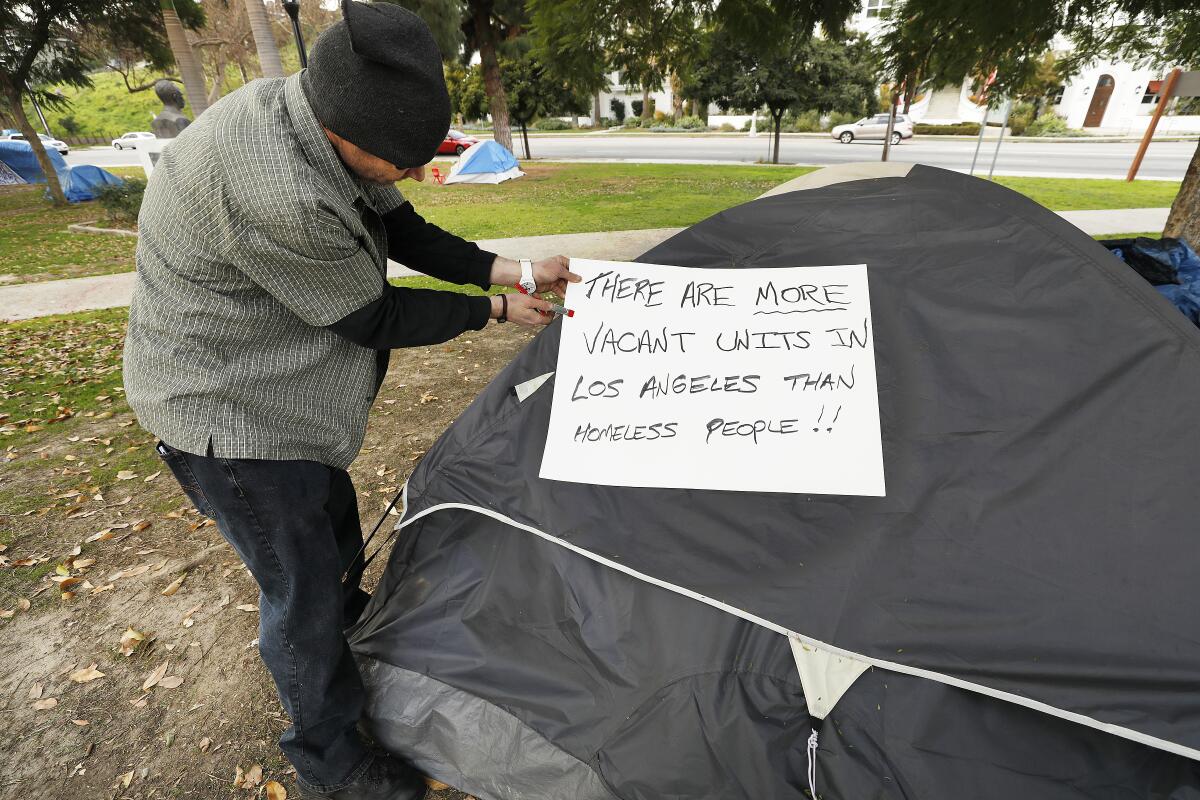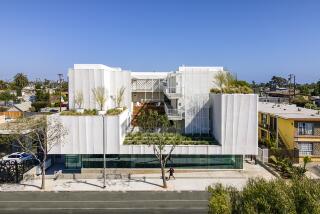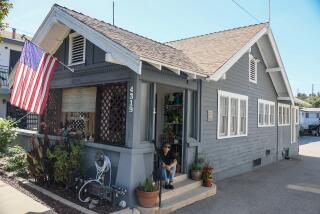Opinion: How did Echo Park become so stratified with landed gentry and poverty? There was a plan 50 years ago

- Share via
Even amid a COVID-19 pandemic that has hit Los Angeles and its neighborhoods like a brick to the head, you’d be hard-pressed to find a place more grim in the city right now than Echo Park.
For nearly two years, a homeless colony with hundreds of inhabitants has been growing steadily along the banks of Echo Park Lake. That colony will be forcibly cleared this week in response to the demands of the neighborhood’s wealthier homeowners and renters, who have grown tired of the park’s deteriorating condition. As a recent petition signed by more than 4,000 neighborhood residents put it: “WE — THE CITIZENS OF ECHO PARK — WILL NO LONGER TOLERATE OUR LAKE BEING DESTROYED!”
City officials say they will shelter displaced Echo Park campers in hotel rooms. But it’s hard to ignore the fact that an impending clearing feels less like a path to permanent housing than a prologue to pushing Echo Park’s homeless population out of sight and out of mind to some other neighborhood, pandemic be damned.
How did things get this bad?
It would be easy to blame COVID-19 and its accompanying economic collapse for the abject inequality and social tensions. But the root of the problems in Echo Park go back decades. And one particular chapter from that history is worth mining now.
Exactly 50 years ago, Echo Park found itself at a similar inflection point — this time with white homeowners pitted against working class Latino renters who were desperate for affordable housing. That battle was laid out in excruciating and blunt detail in a 1971 story by L.A. Times reporter Dial Torgerson, who did not hold back saying the quiet parts about race and class dynamics out loud.
“Not since the black community advanced on Jewish neighborhoods … on the West Side have people of avowed good will been forced into such unaccustomed roles.”
“Just as Jewish residents found themselves fighting against an influx of blacks into their schools, Echo Park’s hill liberals now are fighting federally assisted housing for the underprivileged. People keenly aware of a housing shortage find themselves saying: poor, go elsewhere.”
Torgerson’s prose was problematic, to put it mildly. But make no mistake, his piece is an incredible historical artifact. And the ugliness he documented (and often perpetrated) is essential to understanding how Echo Park wound up where it is today.
A Sept. 19, 1971 L.A. Times story by Dial Torgerson about the effort to preserve neighborhood “ecology” in Echo Park.
To Torgerson’s telling, as a generation of older white homeowners died off in the 1960s, they left their properties to family members who — by and large — preferred life in the suburbs to increasingly diverse Echo Park. Some of these heirs sold their homes. But others held onto the land and became slumlords, letting their properties fall into disrepair and renting them for cheap to whoever was willing to put up with the deteriorating conditions.
They found willing renters by the thousands in the form of working class Latino families who had been displaced by nearby “urban renewal” projects that gutted their neighborhoods.
By 1971, demand for cheap housing in Echo Park outstripped supply. The neighborhood had grown crowded, as Latino families with few other options crammed together into whatever housing units they could find. Gang violence proliferated amid the desperation and neglect.
White homeowners who remained in Echo Park, meanwhile, grew increasingly hostile to what they perceived to be the unsightly, dangerous and increasingly Latino condition of the neighborhood. An expert quoted in Torgerson’s piece put the onus for the neighborhood’s disrepair on single mothers and unruly Latino children rather than the landlords who refused to do upkeep.
“The kids break the door locks so they don’t need a key. They start breaking the windows, writing on the walls. The next time the landlord has to rent it to someone even more desperate. Families with no father, the mother working.... Properties start to deteriorate fast.”
Torgerson himself stated matter of factly that “disadvantaged” Latinos with poor language skills were dragging down the collective IQ of neighborhood schools.
Downtown developers, meanwhile, feared that an influx of Latinos and an exodus of white Echo Park residents would devastate their bottom lines:
“Some observers believe Echo Park must be saved not just for itself, but for its effects on downtown Los Angeles too.”
“If blight settled on Echo Park, the Central City would be surrounded by it, in the classic manner of the slum-surrounded downtowns of the east, with only Wilshire Blvd. corridor and, of course, the safe-conduct lanes of the freeways — connecting it to safer streets beyond.”
The unstated backdrop to this conflict was the passage of the federal Fair Housing Act three years earlier, which banned all forms of overt housing discrimination. Local officials, developers, lenders and white homeowner groups couldn’t conspire to outright ban new Latino arrivals as they might have only a few years before.
And so Echo Park found itself with a choice. It could do the right thing and build enough affordable housing to safely and comfortably accommodate its incoming working class Latino population. Or it could allow those same people to live in slum conditions by restricting the area’s housing supply — praying that white home buyers eventually rediscovered Echo Park’s amenities and gentrified the Latino population away, raising land values and incentivizing the redevelopment of downtown L.A.
A UCLA planning study cited in Torgerson’s piece illuminated these racial politics as clear as day — and on which side of the debate the city’s institutions stood:
“The rapidly changing ethnic composition of the Silver Lake-Echo Park communities will soon transform Echo Park into a Mexican-American barrio. We strongly urge that … steps be taken to avoid further ghettoization.”
UCLA’s recommended path toward whiteness, Torgerson noted, was already underway in 1971 — in the form of efforts “to reduce density to stop inflow of the urban poor.”
With its hills, parks, Craftsman homes and proximity to downtown L.A.’s jobs, the thinking went, Echo Park should be an inevitable destination for white professionals who were either priced out of the suburbs or who didn’t want to deal with soul-crushing traffic on their way to work. But keeping that vision of a gentrified Echo Park alive meant toeing a racial line.
To make things “viable” for white buyers, working Latino renters had to be kept at bay.
Of course Echo Park’s Latino population was well aware of the slander and discrimination it was suffering. And it did its best to push for new affordable housing. But Torgerson reports that push was rejected by politicians and the white homeowners and downtown developers who had their ear — citing the pernicious impact new apartments would have on neighborhood “ecology.” Not only did officials scale back or abandon plans for federally funded affordable housing development, they downzoned Echo Park’s numerous high-density corridors to make sure that future affordable housing would be almost impossible to build in perpetuity.
Torgerson summed up the thinking this way:
“What would happen … if 660 new low-rent units were built in the area? Wouldn’t 660 more families, poor and desperate, fill up the sub-standard units from which the luckier ones moved?”
“Are the poor to inherit Echo Park?”
Fifty years later we know the answer: No, the poor increasingly have no place in Echo Park.
Other neighborhoods behaved similarly to Echo Park around this time. Starting in 1960, L.A. downzoned (that is, lowered) its population capacity from roughly 10 million to 4 million. And just like in Echo Park, the racial ill-intent behind this downzoning wasn’t a secret. L.A.’s white City Council President John Gibson explicitly called his colleagues out on the council floor in 1973 in response to community plans to downzone predominantly white areas of West Los Angeles and the San Fernando Valley.
“What you are doing exactly — and I think you know it, is instead of giving people a chance to move around the city … you have made it impossible to do anything but just make the ghetto larger. That’s exactly what you’ve done.”
Of course, plenty has changed since the 1970s. The past isn’t entirely prologue. Other factors, from L.A.’s history of redlining to the 2008 financial crisis, are also in play. But it’s impossible to ignore the fact that the steps taken to keep working Latinos out of Echo Park 50 years ago look markedly similar to efforts to “preserve neighborhood character” that define so much of L.A.’s contemporary planning strategies: Zone neighborhoods almost exclusively for single family homes, refuse permission to build affordable apartments or bury those that are approved in red tape.
The effect now, just as it was in 1971, is to push out those who can’t afford to buy a single-family home. And to drive those who linger past their welcome into a condition of desperate poverty.
Echo Park has once again reached an impasse. Will it prioritize the demands and esthetic preferences of its affluent, largely white homeowners? Or will it learn from its history and build the affordable housing it needs to become an equitable, inclusive place for everyone who calls it home?
More to Read
A cure for the common opinion
Get thought-provoking perspectives with our weekly newsletter.
You may occasionally receive promotional content from the Los Angeles Times.











